History of AIDS Activism
By: Cassy Boff 2006
According to Brett
C. Stockdill, the AIDS movement, particularly in the late 1980s and continuing
through the early 1990s, is characterized as a movement “because it was composed
of a diverse set of people whose needs were not being met by existing dominant
institutions, such as the government, the medical establishment, and
pharmaceutical corporations, and who used ‘politics by other means’ to further
their collective interests” (2003: 20). For my discussion of AIDS activism, I
will be focusing primarily on the AIDS
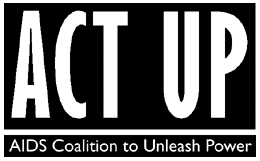 Coalition
to Unleash Power, otherwise known as ACT UP. Influenced by the African American
Civil Rights Movement, ACT UP is a grassroots organization which uses nonviolent
civil disobedience. At its peak, the organization stood up to protest
indifference to the AIDS epidemic by both the government and society at large
(Smith 1998: 36). Commenting on the direct action tactics of the organization,
ACT UP/Chicago member Janet explains, “Instead of ‘Oh we didn’t get this grant,
so we can’t do this,’ it’s ‘You slammed the door in our face—we’re gonna come
kick it down.’ I like the attitude” (Stockdill 2003: 108). Basically, as Janet
seems to explain, ACT UP did not take no as an answer. The organization was
determined to see change and was not afraid to take direct action to be sure its
goals were met.
Coalition
to Unleash Power, otherwise known as ACT UP. Influenced by the African American
Civil Rights Movement, ACT UP is a grassroots organization which uses nonviolent
civil disobedience. At its peak, the organization stood up to protest
indifference to the AIDS epidemic by both the government and society at large
(Smith 1998: 36). Commenting on the direct action tactics of the organization,
ACT UP/Chicago member Janet explains, “Instead of ‘Oh we didn’t get this grant,
so we can’t do this,’ it’s ‘You slammed the door in our face—we’re gonna come
kick it down.’ I like the attitude” (Stockdill 2003: 108). Basically, as Janet
seems to explain, ACT UP did not take no as an answer. The organization was
determined to see change and was not afraid to take direct action to be sure its
goals were met.
The movement’s
origins can be traced back to playwright and AIDS activist Larry Kramer. In
March of 1987, Kramer addressed the crowd in New York at the Lesbian and Gay
Community Service Center where he asked “Do we want to start a new organization
devoted solely to political action?” ( Smith 1998: 36). This question inspired
another meeting at the NY center just a few days later where over 300 people
attended and this event is considered the beginning of ACT UP. From then on,
ACT UP/New York held weekly meetings who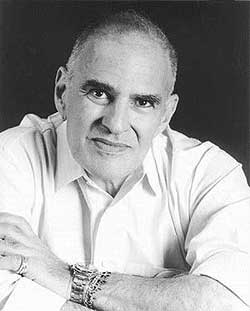 se
attendance numbered over 800 people per meeting, making NY the leading chapter.
By 1988, many other chapters had sprung up across the country in places like Los
Angeles, Boston, Chicago, and San Francisco. ACT UP had reached a total of more
then 100 chapters worldwide by 1990. The original goal of the organization was
to insist on the release of experimental AIDS drugs (Smith 1998:
36-37). As taken directly from the ACT UP Website, “ACT UP, or the AIDS
Coalition to Unleash Power is a non-partisan group of individuals united in
anger and commitment to direct action to end the AIDS crisis” (ACT UP). These
central goals are stated at the commencement of every meeting.
se
attendance numbered over 800 people per meeting, making NY the leading chapter.
By 1988, many other chapters had sprung up across the country in places like Los
Angeles, Boston, Chicago, and San Francisco. ACT UP had reached a total of more
then 100 chapters worldwide by 1990. The original goal of the organization was
to insist on the release of experimental AIDS drugs (Smith 1998:
36-37). As taken directly from the ACT UP Website, “ACT UP, or the AIDS
Coalition to Unleash Power is a non-partisan group of individuals united in
anger and commitment to direct action to end the AIDS crisis” (ACT UP). These
central goals are stated at the commencement of every meeting.
Emerging partly as
a response to the gay and lesbian movement, ACT UP had no elected leaders or
appointed spokespersons because the group believed that no one member had the
right to speak on behalf of the entire group. Therefore, there was really no
formal structure to the organization. In this sense, all members were seen as
equal; however there was not extreme diversity among the people of the group.
For example, as Marcia C. Inhorn’s review of Stockdill’s book explains,
“Namely, activists of color were generally discouraged from ACT UP-style
disobedience because of their communities’ histories of government repression,
including police brutality, grand juries, FBI surveillance, violence, and
assassinations.” She continues saying, “Similarly, homophobia in communities of
color, including many black and Latino churches preaching that homosexuality is
a sin, led to the invisibility of gays and lesbians of color and lack of
interest in AIDS activism in these communities” (2004: 276). Overall, although
there was a sense of equality among members of the organization, it was very
much dominated by Caucasians and therefore did not have a very equal
representation.
Over time, the
organization expanded upon its original goals and begun to make a number of more
specific demands. Firstly, the organization has “demanded that the U.S. Food and
Drug Administration (FDA)
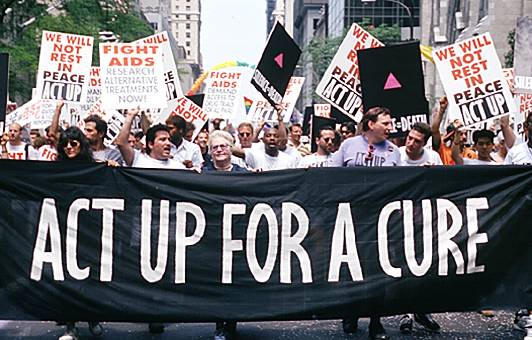 release
AIDS drugs in a timely manner by shortening the drug approval process” (Smith
1998: 37). It also urged private health insurance companies and Medicaid to pay
for experimental drug therapies. In addition, they have petitioned for the
“creation and implementation of a federal needle-exchange program, called for a
federally controlled and funded program of condom distribution at the local
level, and asked for a serious sex education program in primary and secondary
schools to be created and monitored by the Federal Department of Education”
(Smith 1988: 37). ACT UP also exposed the high prices and the large profits
earned by Pharmaceutical companies for AIDS medication to show that the
companies often pursued profits at the expense of lives. Members urged companies
to lower prices so that the drugs would be readily available to people with
HIV/AIDS from various background and classes (Smith 1998: 37).
release
AIDS drugs in a timely manner by shortening the drug approval process” (Smith
1998: 37). It also urged private health insurance companies and Medicaid to pay
for experimental drug therapies. In addition, they have petitioned for the
“creation and implementation of a federal needle-exchange program, called for a
federally controlled and funded program of condom distribution at the local
level, and asked for a serious sex education program in primary and secondary
schools to be created and monitored by the Federal Department of Education”
(Smith 1988: 37). ACT UP also exposed the high prices and the large profits
earned by Pharmaceutical companies for AIDS medication to show that the
companies often pursued profits at the expense of lives. Members urged companies
to lower prices so that the drugs would be readily available to people with
HIV/AIDS from various background and classes (Smith 1998: 37).
In an attempt to
gain media coverage to draw support for their cause, activists often used
slogans such as SILENCE=DEATH. By using popular phrases like these, activists
hoped people would realize that if the message about the AIDS epidemic was not
spread, people would continue dying. Also, political art was often used to help
convey their message to larger society. One memorable artistic contribution to
the activist movement came with the premiere of the AIDS Quilt Songbook
at Lincoln Center’s Alice Tully Hall on June 4, 1992. Yet, the goal of gaining
media coverage was soon met when ACT UP held its first demonstration on Wall
Street, New York’s financial center, on March 24, 1987. Members felt that the
FDA, which is responsible for ensuring that our drug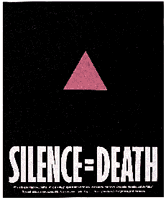 supply is safe and effective, was taking far too long in its approval process
while people with
supply is safe and effective, was taking far too long in its approval process
while people with
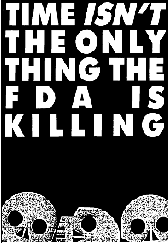 AIDS
were dying in the meantime. The main purpose of the demonstration was to
“heighten awareness of the FDA’s inability to overcome its own bureaucracy and
release experimental AIDS drugs in a timely fashion” (Smith 1998: 38). As a
result, 17 people were arrested but overall it was successful because shortly
after, the FDA agreed to shorten its drug approval process by two years. Not
long after, on June 1, 1987, a coalition of activists assembled at the White
House to demand real action against AIDS in response to Ronald Reagan’s first
public address about the epidemic (Smith 1998: 37-38). Reagan felt that the
government should not provide sex education information. Although the first AIDS
case had been publicly recognized in the media by 1981, it was not until October
1987 that Reagan mentioned the word “AIDS” on public television. On April 2,
1987, Reagan gave a speech saying: "How that information is used must be up to
schools and parents, not government. But let's be honest with ourselves, AIDS
information cannot be what some call 'value neutral.' After all, when it comes
to preventing AIDS, don't medicine and morality teach the same lessons?” By the
closing of that year 59,572 AIDS cases had been reported and 27,909 of those
cases had resulted in death (ACT UP NY).
AIDS
were dying in the meantime. The main purpose of the demonstration was to
“heighten awareness of the FDA’s inability to overcome its own bureaucracy and
release experimental AIDS drugs in a timely fashion” (Smith 1998: 38). As a
result, 17 people were arrested but overall it was successful because shortly
after, the FDA agreed to shorten its drug approval process by two years. Not
long after, on June 1, 1987, a coalition of activists assembled at the White
House to demand real action against AIDS in response to Ronald Reagan’s first
public address about the epidemic (Smith 1998: 37-38). Reagan felt that the
government should not provide sex education information. Although the first AIDS
case had been publicly recognized in the media by 1981, it was not until October
1987 that Reagan mentioned the word “AIDS” on public television. On April 2,
1987, Reagan gave a speech saying: "How that information is used must be up to
schools and parents, not government. But let's be honest with ourselves, AIDS
information cannot be what some call 'value neutral.' After all, when it comes
to preventing AIDS, don't medicine and morality teach the same lessons?” By the
closing of that year 59,572 AIDS cases had been reported and 27,909 of those
cases had resulted in death (ACT UP NY).
However, ACT UP
did not stop there, but rather continued fighting to make its voice heard. Just
a few days later another demonstration took place at the NY office of Northwest
Airlines in response to their refusal to seat a man with AIDS. Because of this
demonstration, two suits were brought against the airline and the policy was
eventually reversed. But the action of ACT UP did not stop here. On June 21,
1987 a round the clock, four day long protest was held at the Memorial
Sloan-Kettering Hospital of New York calling for an increased amount of anti-HIV
drug trials and demanding that more people with AIDS be involved in them. The
following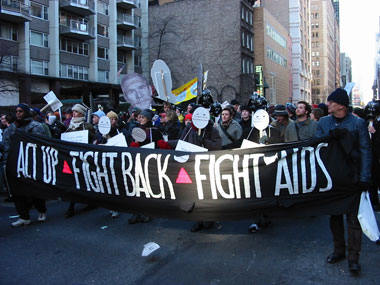 year on January 15, a group of 500 protestors challenged an article from
Cosmopolitan magazine which claimed that heterosexual women who had unprotected
vaginal sex with HIV+ males were safe and would not contract the disease. This
1988 protest marked the first action taken by ACT UP which primarily concerned
women and HIV. On October 11 of that same year, the organization was joined by
the national ACT NOW organization to surround the FDA building in Maryland.
Together, the total number of activists exceeded 1,000 and the demonstration
resulted in over 180 arrests and worldwide media coverage (ACT UP NY).
“Admittedly, the FDA protests staged by ACT UP do not qualify as defining
moments in the same sense, say, as Stonewall did for the gay rights movement or
the Greensboro lunch counter sit-in did for civil rights. Nevertheless, the FDA
actions have great symbolic meaning for the AIDS movement” (Jennings and
Andersen 2003: 191). This statement holds very true because the focus of much of
the work ACT UP did was an attempt to challenge the FDA process and demand
change.
year on January 15, a group of 500 protestors challenged an article from
Cosmopolitan magazine which claimed that heterosexual women who had unprotected
vaginal sex with HIV+ males were safe and would not contract the disease. This
1988 protest marked the first action taken by ACT UP which primarily concerned
women and HIV. On October 11 of that same year, the organization was joined by
the national ACT NOW organization to surround the FDA building in Maryland.
Together, the total number of activists exceeded 1,000 and the demonstration
resulted in over 180 arrests and worldwide media coverage (ACT UP NY).
“Admittedly, the FDA protests staged by ACT UP do not qualify as defining
moments in the same sense, say, as Stonewall did for the gay rights movement or
the Greensboro lunch counter sit-in did for civil rights. Nevertheless, the FDA
actions have great symbolic meaning for the AIDS movement” (Jennings and
Andersen 2003: 191). This statement holds very true because the focus of much of
the work ACT UP did was an attempt to challenge the FDA process and demand
change.
Just like the
previous years, 1989 displayed a wide array of action by the ACT UP
organization. A demonstration was held at the U.S. Civil Rights Commission’s
AIDS hearing. Later in the year, ACT UP joined
 with
WHAM (Women’s Health Action and Mobilization) to hold the “Stop the Church”
demonstration. Together, over 4,500 members of both organizations disrupted a
mass being given by Cardinal O’Connor at St. Patrick’s Cathedral to protest his
opposition to safer sex education, violent homophobia, and his attempts to block
access to safe and legal abortions. When all was done, 111 arrests were made,
and many began to claim that ACT UP had simply gone too far (ACT UP NY).
Another widely publicized event took place on January 20, 1991 when ACT UP
members overran the studio of the MacNeil/Lehrer Newshour and chained themselves
to Robert MacNeil’s desk during an on-air broadcast. The public could clearly
see the sign which members flashed stating “The AIDS Crisis is Not Over.” By
1992, as a result of the negative criticism, divisions over what should be
appropriate political strategy had begun to arise and in turn began to undermine
the solidarity of the movement (Smith 1998: 39).
with
WHAM (Women’s Health Action and Mobilization) to hold the “Stop the Church”
demonstration. Together, over 4,500 members of both organizations disrupted a
mass being given by Cardinal O’Connor at St. Patrick’s Cathedral to protest his
opposition to safer sex education, violent homophobia, and his attempts to block
access to safe and legal abortions. When all was done, 111 arrests were made,
and many began to claim that ACT UP had simply gone too far (ACT UP NY).
Another widely publicized event took place on January 20, 1991 when ACT UP
members overran the studio of the MacNeil/Lehrer Newshour and chained themselves
to Robert MacNeil’s desk during an on-air broadcast. The public could clearly
see the sign which members flashed stating “The AIDS Crisis is Not Over.” By
1992, as a result of the negative criticism, divisions over what should be
appropriate political strategy had begun to arise and in turn began to undermine
the solidarity of the movement (Smith 1998: 39).
Conflicting
ideologies within the AIDS movement were often the causes of internal clashes.
For instance, within ACT UP, two distinct perspectives lead to frequent
conflict. One perspective, which incorporated partial oppositional
consciousness, framed AIDS as “a discrete social problem unrelated to sexism,
classism, and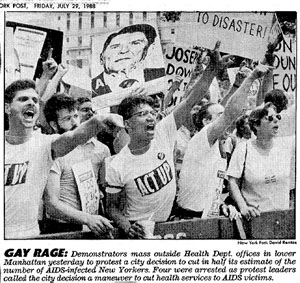 racism” (Stockdill 2003: 149). This idea was typically supported by white,
middle-class, homosexual men who had very little prior activist involvement.
Opposition consciousness in this perspective focused on homophobia/AIDSphobia
and excluded other types of domination. For this reason, the strategies employed
usually centered on searching for “a cure to HIV/AIDS, access to clinical drug
trials, speedier government approval of promising treatments, reduction of the
cost of antiviral medications, and other related issues” (Stockdill 2003:150).
As a result, many significant gains in the areas of AIDS treatment and research
were made. However, there was a great lack of understanding to how these issues
affected the poor, women, and people of color (Stockdill 2003: 149-150).
racism” (Stockdill 2003: 149). This idea was typically supported by white,
middle-class, homosexual men who had very little prior activist involvement.
Opposition consciousness in this perspective focused on homophobia/AIDSphobia
and excluded other types of domination. For this reason, the strategies employed
usually centered on searching for “a cure to HIV/AIDS, access to clinical drug
trials, speedier government approval of promising treatments, reduction of the
cost of antiviral medications, and other related issues” (Stockdill 2003:150).
As a result, many significant gains in the areas of AIDS treatment and research
were made. However, there was a great lack of understanding to how these issues
affected the poor, women, and people of color (Stockdill 2003: 149-150).
The counter
perspective within ACT UP instead illustrated that AIDS is a collaboration of
homophobia, racism, classism, and sexism. In contrast to those of the other
perspective, these members were generally women and people of color, most who
had previous activist experience. Overall, this perspective gave more attention
to social groups that are often ignored by mainstream activists. In making
demands, members of this perspective fought for a wider range of approaches
which focused on the impact of AIDS on drug users, prisoners, women of color,
and the poor. Divisions over these views even lead certain ACT UP chapters to
split into two separate groups. Overall, these conflicts reduced the
effectiveness of the AIDS movement (Stockdill 2003: 149-150). The group of
activists who enforced a political strategy of emphasizing the treatment of
individuals with HIV/AIDS branched off to form the Treatment Action Group (TAG).
This organization accepted members only by invitation, and unlike ACT UP, some
members even received salaries (Smith 1998: 39).
ACT UP boldly
confronted many forms of inequality including homophobia, and as a result, they
were the target of brutality from the police force, surveillance by the FBI, and
even criminal prosecution. Because the militant politic of ACT UP was frowned
upon by mass media, the police, and the government alike, many other sections
of the AIDS movement began to distance themselves from the organization, leading
to a break down of
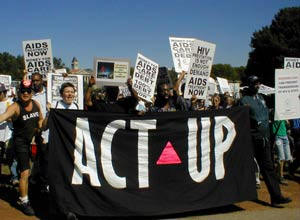 the
coalition that had been building across the movement as a whole. Moreover, the
fear and difficulty of living with HIV also served to inhibit many people from
action. It was not until around 1995 that protease inhibitors were readily
available, which made it very difficult for many to participate in the movement
before that time. When they did participate, fatigue lead to relatively quick
burnouts. “The targeting of ACT UP by the FBI, police, and courts was one
important factor in the decline of street-level AIDS protest in the mid-1990s” (Stockdill
2003:156). By 1996, the organization was largely broken by these internal
divisions. ACT UP’s use of direct action showed how effective unconventional
politics could be in spite of unresponsiveness from policy elites. “In this and
in other ways, ACT UP has made an invaluable contribution to saving people’s
lives in the face of government and societal indifference” (Smith 1998: 40).
the
coalition that had been building across the movement as a whole. Moreover, the
fear and difficulty of living with HIV also served to inhibit many people from
action. It was not until around 1995 that protease inhibitors were readily
available, which made it very difficult for many to participate in the movement
before that time. When they did participate, fatigue lead to relatively quick
burnouts. “The targeting of ACT UP by the FBI, police, and courts was one
important factor in the decline of street-level AIDS protest in the mid-1990s” (Stockdill
2003:156). By 1996, the organization was largely broken by these internal
divisions. ACT UP’s use of direct action showed how effective unconventional
politics could be in spite of unresponsiveness from policy elites. “In this and
in other ways, ACT UP has made an invaluable contribution to saving people’s
lives in the face of government and societal indifference” (Smith 1998: 40).
All things
considered, ACT UP made several important accomplishments, one large one being
the “parallel track” proposal under which people with AIDS can receive
medication even before it is approved through the FDA process. Also, as a result
of ACT UP protest, the pharmaceutical company Burroughs Welcome drastically
reduced the price of AZT, and other companies have followed by reducing their
cost of AIDS related medicine. Another accomplishment by ACT UP was its
alteration of the definition of AIDS to include women and guarantee that they be
included in drug trials and received disability benefits. In addition, the
organization also established needle-exchange programs which are believed to
have contributed to a reduction in the rate of HIV infection amongst injecting
drug users and their partners (Smith 1998: 40).
Although
criticized for its lack of organization, chaotic meetings, and the sometimes
over the top direct action taken, ACT UP has been an important part of the
activism against AIDS movement raising awareness about AIDS, getting the
government more involved in stopping its spread, and sending the message of
acceptance rather then discrimination of those who have the disease. “AIDS is an
epidemic that not only drastically affects individual lives but one that also
became politically charged because of the controversy surrounding the nature and
suppression of its transmission, its concentration in identifiable population
segments, the high cost of medical care, and the priorities to be assigned to
seeking a cure” (Jennings and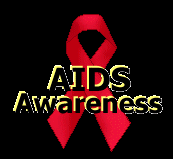 Andersen 2003: 179). Even though AIDS was a controversial issue of the time,
AIDS activists disregarded this notion and continued to fight for social change.
Working alongside other organizations like the People With AIDS (PWA) Self
Empowerment Group, United for AIDS Action (UAA), and Women's Health Action and
Mobilization (WHAM!), ACT UP can be credited with making an invaluable
contribution to the AIDS movement. Just as the AIDS Quilt aimed to visually
show the immensity of the epidemic, various activist groups worked together in
action to raise awareness and demand assistance. “At its most radical points,
ACT UP worked to expose how the devastation caused by the AIDS epidemic has been
fueled by systematic oppression. In doing so, the organization moved beyond more
moderate movement organizations that have typically worked within the system
rather than challenging it” (Stockdill 2003:156). Even though the movement died
out for the most part by the mid 1990s, today activism against AIDS still exists
and organizations like ACT UP still thrive, although to a much lesser degree
then during the AIDS movement.
Andersen 2003: 179). Even though AIDS was a controversial issue of the time,
AIDS activists disregarded this notion and continued to fight for social change.
Working alongside other organizations like the People With AIDS (PWA) Self
Empowerment Group, United for AIDS Action (UAA), and Women's Health Action and
Mobilization (WHAM!), ACT UP can be credited with making an invaluable
contribution to the AIDS movement. Just as the AIDS Quilt aimed to visually
show the immensity of the epidemic, various activist groups worked together in
action to raise awareness and demand assistance. “At its most radical points,
ACT UP worked to expose how the devastation caused by the AIDS epidemic has been
fueled by systematic oppression. In doing so, the organization moved beyond more
moderate movement organizations that have typically worked within the system
rather than challenging it” (Stockdill 2003:156). Even though the movement died
out for the most part by the mid 1990s, today activism against AIDS still exists
and organizations like ACT UP still thrive, although to a much lesser degree
then during the AIDS movement.
References
“ACT UP: AIDS Coalition to Unleash Power.” Retrieved Oct. 2, 2006
(http://www.actupny.org/).
“The AIDS Memorial Quilt.” 2005. The NAMES Project Foundation.
Retrieved Nov. 12,
2006. (http://www.aidsquilt.org).
Grmek, Mirko D. 1990. History of AIDS. Princeton, NJ:
Princeton University Press.
Inhorn, Marcia C. 2004. “Book Reviews.” American Journal of
Sociology 110(1): 275-277.
Jennings, M. Kent and Ellen Ann Andersen. 2003. “The Importance
of Social and Political
Context: The Case of AIDS Activism.” Political
Behavior 25(2): 177-199.
Smith, Raymond A., Ed. The Encyclopedia
of AIDS: A Social, Political, Cultural, and
Scientific Record of the HIV Epidemic.
1998. Fitzroy Dearborn Publishers.
Stockdill, Brett C. 2003. Activism
Against AIDS: At the Intersections of Sexuality, Race,
Gender, and Class.
Boulder, CO: Lynne Rienner Publishers, Inc.
 Coalition
to Unleash Power, otherwise known as ACT UP. Influenced by the African American
Civil Rights Movement, ACT UP is a grassroots organization which uses nonviolent
civil disobedience. At its peak, the organization stood up to protest
indifference to the AIDS epidemic by both the government and society at large
(Smith 1998: 36). Commenting on the direct action tactics of the organization,
ACT UP/Chicago member Janet explains, “Instead of ‘Oh we didn’t get this grant,
so we can’t do this,’ it’s ‘You slammed the door in our face—we’re gonna come
kick it down.’ I like the attitude” (Stockdill 2003: 108). Basically, as Janet
seems to explain, ACT UP did not take no as an answer. The organization was
determined to see change and was not afraid to take direct action to be sure its
goals were met.
Coalition
to Unleash Power, otherwise known as ACT UP. Influenced by the African American
Civil Rights Movement, ACT UP is a grassroots organization which uses nonviolent
civil disobedience. At its peak, the organization stood up to protest
indifference to the AIDS epidemic by both the government and society at large
(Smith 1998: 36). Commenting on the direct action tactics of the organization,
ACT UP/Chicago member Janet explains, “Instead of ‘Oh we didn’t get this grant,
so we can’t do this,’ it’s ‘You slammed the door in our face—we’re gonna come
kick it down.’ I like the attitude” (Stockdill 2003: 108). Basically, as Janet
seems to explain, ACT UP did not take no as an answer. The organization was
determined to see change and was not afraid to take direct action to be sure its
goals were met. se
attendance numbered over 800 people per meeting, making NY the leading chapter.
By 1988, many other chapters had sprung up across the country in places like Los
Angeles, Boston, Chicago, and San Francisco. ACT UP had reached a total of more
then 100 chapters worldwide by 1990. The original goal of the organization was
to insist on the release of experimental AIDS drugs (Smith 1998:
36-37). As taken directly from the ACT UP Website, “ACT UP, or the AIDS
Coalition to Unleash Power is a non-partisan group of individuals united in
anger and commitment to direct action to end the AIDS crisis” (ACT UP). These
central goals are stated at the commencement of every meeting.
se
attendance numbered over 800 people per meeting, making NY the leading chapter.
By 1988, many other chapters had sprung up across the country in places like Los
Angeles, Boston, Chicago, and San Francisco. ACT UP had reached a total of more
then 100 chapters worldwide by 1990. The original goal of the organization was
to insist on the release of experimental AIDS drugs (Smith 1998:
36-37). As taken directly from the ACT UP Website, “ACT UP, or the AIDS
Coalition to Unleash Power is a non-partisan group of individuals united in
anger and commitment to direct action to end the AIDS crisis” (ACT UP). These
central goals are stated at the commencement of every meeting.  release
AIDS drugs in a timely manner by shortening the drug approval process” (Smith
1998: 37). It also urged private health insurance companies and Medicaid to pay
for experimental drug therapies. In addition, they have petitioned for the
“creation and implementation of a federal needle-exchange program, called for a
federally controlled and funded program of condom distribution at the local
level, and asked for a serious sex education program in primary and secondary
schools to be created and monitored by the Federal Department of Education”
(Smith 1988: 37). ACT UP also exposed the high prices and the large profits
earned by Pharmaceutical companies for AIDS medication to show that the
companies often pursued profits at the expense of lives. Members urged companies
to lower prices so that the drugs would be readily available to people with
HIV/AIDS from various background and classes (Smith 1998: 37).
release
AIDS drugs in a timely manner by shortening the drug approval process” (Smith
1998: 37). It also urged private health insurance companies and Medicaid to pay
for experimental drug therapies. In addition, they have petitioned for the
“creation and implementation of a federal needle-exchange program, called for a
federally controlled and funded program of condom distribution at the local
level, and asked for a serious sex education program in primary and secondary
schools to be created and monitored by the Federal Department of Education”
(Smith 1988: 37). ACT UP also exposed the high prices and the large profits
earned by Pharmaceutical companies for AIDS medication to show that the
companies often pursued profits at the expense of lives. Members urged companies
to lower prices so that the drugs would be readily available to people with
HIV/AIDS from various background and classes (Smith 1998: 37). supply is safe and effective, was taking far too long in its approval process
while people with
supply is safe and effective, was taking far too long in its approval process
while people with
 AIDS
were dying in the meantime. The main purpose of the demonstration was to
“heighten awareness of the FDA’s inability to overcome its own bureaucracy and
release experimental AIDS drugs in a timely fashion” (Smith 1998: 38). As a
result, 17 people were arrested but overall it was successful because shortly
after, the FDA agreed to shorten its drug approval process by two years. Not
long after, on June 1, 1987, a coalition of activists assembled at the White
House to demand real action against AIDS in response to Ronald Reagan’s first
public address about the epidemic (Smith 1998: 37-38). Reagan felt that the
government should not provide sex education information. Although the first AIDS
case had been publicly recognized in the media by 1981, it was not until October
1987 that Reagan mentioned the word “AIDS” on public television. On April 2,
1987, Reagan gave a speech saying: "How that information is used must be up to
schools and parents, not government. But let's be honest with ourselves, AIDS
information cannot be what some call 'value neutral.' After all, when it comes
to preventing AIDS, don't medicine and morality teach the same lessons?” By the
closing of that year 59,572 AIDS cases had been reported and 27,909 of those
cases had resulted in death (ACT UP NY).
AIDS
were dying in the meantime. The main purpose of the demonstration was to
“heighten awareness of the FDA’s inability to overcome its own bureaucracy and
release experimental AIDS drugs in a timely fashion” (Smith 1998: 38). As a
result, 17 people were arrested but overall it was successful because shortly
after, the FDA agreed to shorten its drug approval process by two years. Not
long after, on June 1, 1987, a coalition of activists assembled at the White
House to demand real action against AIDS in response to Ronald Reagan’s first
public address about the epidemic (Smith 1998: 37-38). Reagan felt that the
government should not provide sex education information. Although the first AIDS
case had been publicly recognized in the media by 1981, it was not until October
1987 that Reagan mentioned the word “AIDS” on public television. On April 2,
1987, Reagan gave a speech saying: "How that information is used must be up to
schools and parents, not government. But let's be honest with ourselves, AIDS
information cannot be what some call 'value neutral.' After all, when it comes
to preventing AIDS, don't medicine and morality teach the same lessons?” By the
closing of that year 59,572 AIDS cases had been reported and 27,909 of those
cases had resulted in death (ACT UP NY). year on January 15, a group of 500 protestors challenged an article from
Cosmopolitan magazine which claimed that heterosexual women who had unprotected
vaginal sex with HIV+ males were safe and would not contract the disease. This
1988 protest marked the first action taken by ACT UP which primarily concerned
women and HIV. On October 11 of that same year, the organization was joined by
the national ACT NOW organization to surround the FDA building in Maryland.
Together, the total number of activists exceeded 1,000 and the demonstration
resulted in over 180 arrests and worldwide media coverage (ACT UP NY).
“Admittedly, the FDA protests staged by ACT UP do not qualify as defining
moments in the same sense, say, as Stonewall did for the gay rights movement or
the Greensboro lunch counter sit-in did for civil rights. Nevertheless, the FDA
actions have great symbolic meaning for the AIDS movement” (Jennings and
Andersen 2003: 191). This statement holds very true because the focus of much of
the work ACT UP did was an attempt to challenge the FDA process and demand
change.
year on January 15, a group of 500 protestors challenged an article from
Cosmopolitan magazine which claimed that heterosexual women who had unprotected
vaginal sex with HIV+ males were safe and would not contract the disease. This
1988 protest marked the first action taken by ACT UP which primarily concerned
women and HIV. On October 11 of that same year, the organization was joined by
the national ACT NOW organization to surround the FDA building in Maryland.
Together, the total number of activists exceeded 1,000 and the demonstration
resulted in over 180 arrests and worldwide media coverage (ACT UP NY).
“Admittedly, the FDA protests staged by ACT UP do not qualify as defining
moments in the same sense, say, as Stonewall did for the gay rights movement or
the Greensboro lunch counter sit-in did for civil rights. Nevertheless, the FDA
actions have great symbolic meaning for the AIDS movement” (Jennings and
Andersen 2003: 191). This statement holds very true because the focus of much of
the work ACT UP did was an attempt to challenge the FDA process and demand
change.  with
WHAM (Women’s Health Action and Mobilization) to hold the “Stop the Church”
demonstration. Together, over 4,500 members of both organizations disrupted a
mass being given by Cardinal O’Connor at St. Patrick’s Cathedral to protest his
opposition to safer sex education, violent homophobia, and his attempts to block
access to safe and legal abortions. When all was done, 111 arrests were made,
and many began to claim that ACT UP had simply gone too far (ACT UP NY).
Another widely publicized event took place on January 20, 1991 when ACT UP
members overran the studio of the MacNeil/Lehrer Newshour and chained themselves
to Robert MacNeil’s desk during an on-air broadcast. The public could clearly
see the sign which members flashed stating “The AIDS Crisis is Not Over.” By
1992, as a result of the negative criticism, divisions over what should be
appropriate political strategy had begun to arise and in turn began to undermine
the solidarity of the movement (Smith 1998: 39).
with
WHAM (Women’s Health Action and Mobilization) to hold the “Stop the Church”
demonstration. Together, over 4,500 members of both organizations disrupted a
mass being given by Cardinal O’Connor at St. Patrick’s Cathedral to protest his
opposition to safer sex education, violent homophobia, and his attempts to block
access to safe and legal abortions. When all was done, 111 arrests were made,
and many began to claim that ACT UP had simply gone too far (ACT UP NY).
Another widely publicized event took place on January 20, 1991 when ACT UP
members overran the studio of the MacNeil/Lehrer Newshour and chained themselves
to Robert MacNeil’s desk during an on-air broadcast. The public could clearly
see the sign which members flashed stating “The AIDS Crisis is Not Over.” By
1992, as a result of the negative criticism, divisions over what should be
appropriate political strategy had begun to arise and in turn began to undermine
the solidarity of the movement (Smith 1998: 39).  racism” (Stockdill 2003: 149). This idea was typically supported by white,
middle-class, homosexual men who had very little prior activist involvement.
Opposition consciousness in this perspective focused on homophobia/AIDSphobia
and excluded other types of domination. For this reason, the strategies employed
usually centered on searching for “a cure to HIV/AIDS, access to clinical drug
trials, speedier government approval of promising treatments, reduction of the
cost of antiviral medications, and other related issues” (Stockdill 2003:150).
As a result, many significant gains in the areas of AIDS treatment and research
were made. However, there was a great lack of understanding to how these issues
affected the poor, women, and people of color (Stockdill 2003: 149-150).
racism” (Stockdill 2003: 149). This idea was typically supported by white,
middle-class, homosexual men who had very little prior activist involvement.
Opposition consciousness in this perspective focused on homophobia/AIDSphobia
and excluded other types of domination. For this reason, the strategies employed
usually centered on searching for “a cure to HIV/AIDS, access to clinical drug
trials, speedier government approval of promising treatments, reduction of the
cost of antiviral medications, and other related issues” (Stockdill 2003:150).
As a result, many significant gains in the areas of AIDS treatment and research
were made. However, there was a great lack of understanding to how these issues
affected the poor, women, and people of color (Stockdill 2003: 149-150). the
coalition that had been building across the movement as a whole. Moreover, the
fear and difficulty of living with HIV also served to inhibit many people from
action. It was not until around 1995 that protease inhibitors were readily
available, which made it very difficult for many to participate in the movement
before that time. When they did participate, fatigue lead to relatively quick
burnouts. “The targeting of ACT UP by the FBI, police, and courts was one
important factor in the decline of street-level AIDS protest in the mid-1990s” (Stockdill
2003:156). By 1996, the organization was largely broken by these internal
divisions. ACT UP’s use of direct action showed how effective unconventional
politics could be in spite of unresponsiveness from policy elites. “In this and
in other ways, ACT UP has made an invaluable contribution to saving people’s
lives in the face of government and societal indifference” (Smith 1998: 40).
the
coalition that had been building across the movement as a whole. Moreover, the
fear and difficulty of living with HIV also served to inhibit many people from
action. It was not until around 1995 that protease inhibitors were readily
available, which made it very difficult for many to participate in the movement
before that time. When they did participate, fatigue lead to relatively quick
burnouts. “The targeting of ACT UP by the FBI, police, and courts was one
important factor in the decline of street-level AIDS protest in the mid-1990s” (Stockdill
2003:156). By 1996, the organization was largely broken by these internal
divisions. ACT UP’s use of direct action showed how effective unconventional
politics could be in spite of unresponsiveness from policy elites. “In this and
in other ways, ACT UP has made an invaluable contribution to saving people’s
lives in the face of government and societal indifference” (Smith 1998: 40). Andersen 2003: 179). Even though AIDS was a controversial issue of the time,
AIDS activists disregarded this notion and continued to fight for social change.
Working alongside other organizations like the People With AIDS (PWA) Self
Empowerment Group, United for AIDS Action (UAA), and Women's Health Action and
Mobilization (WHAM!), ACT UP can be credited with making an invaluable
contribution to the AIDS movement. Just as the AIDS Quilt aimed to visually
show the immensity of the epidemic, various activist groups worked together in
action to raise awareness and demand assistance. “At its most radical points,
ACT UP worked to expose how the devastation caused by the AIDS epidemic has been
fueled by systematic oppression. In doing so, the organization moved beyond more
moderate movement organizations that have typically worked within the system
rather than challenging it” (Stockdill 2003:156). Even though the movement died
out for the most part by the mid 1990s, today activism against AIDS still exists
and organizations like ACT UP still thrive, although to a much lesser degree
then during the AIDS movement.
Andersen 2003: 179). Even though AIDS was a controversial issue of the time,
AIDS activists disregarded this notion and continued to fight for social change.
Working alongside other organizations like the People With AIDS (PWA) Self
Empowerment Group, United for AIDS Action (UAA), and Women's Health Action and
Mobilization (WHAM!), ACT UP can be credited with making an invaluable
contribution to the AIDS movement. Just as the AIDS Quilt aimed to visually
show the immensity of the epidemic, various activist groups worked together in
action to raise awareness and demand assistance. “At its most radical points,
ACT UP worked to expose how the devastation caused by the AIDS epidemic has been
fueled by systematic oppression. In doing so, the organization moved beyond more
moderate movement organizations that have typically worked within the system
rather than challenging it” (Stockdill 2003:156). Even though the movement died
out for the most part by the mid 1990s, today activism against AIDS still exists
and organizations like ACT UP still thrive, although to a much lesser degree
then during the AIDS movement.